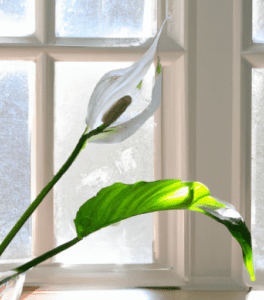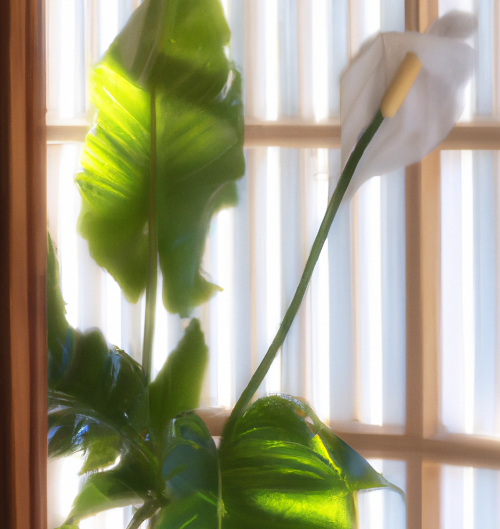Peace Lillies are great indoor plants that are enjoyed around the world. They bring a lovely feel to a room with their vibrant green leaves and stunning white flower. They symbolise peace and bring a metaphorical ray of sunshine into the lives of the people that appreciate their beauty.
Relatively easy to maintain, the Peace Lily can be an excellent choice for an indoor plant.
Peace Lily Origins and Significance
The Peace Lily (Spathiphyllum spp.) is a perennial favorite among plant enthusiasts and those seeking to imbue their spaces with a touch of green and a hint of elegance. Its lush foliage and pure, white blooms embody more than aesthetic beauty – they also represent peace, innocence, and hope.
The Peace Lily traces its roots to the tropical rainforests of Central and South America. Evolving in a humid environment beneath towering canopies, these plants have adapted to flourish in lower light conditions. This adaptability is a significant reason they have become a beloved indoor plant across the globe.
Peace Lily Color and Characteristics

The leaves of the Peace Lily stand out with their characteristic lanceolate shape. These leaves are typically a vibrant green, although some varieties might boast deeper colors.
The leaves are typically shiny and slightly leathery to the touch. This leaf structure plays a crucial role in their ability to survive in both shaded environments and the occasional forgetfulness of a gardener. It allows them to retain moisture and remain robust even when not in direct sunlight.
The flowers, often mistaken for petals, are, in reality, a specialized leaf bract called a spathe. The actual flowers are tiny and reside on the central stalk or spadix. These spathix, when in full bloom, often have a creamy white color.
Caring and Maintenance of Peace Lilies
- Soil and Compost Preferences: The Peace Lily is quite forgiving when it comes to soil types. However, it thrives best in well-draining soil that retains moisture without becoming waterlogged. A mix of potting soil with a touch of perlite or sand proves effective. Regular application of a balanced, water-soluble fertilizer during its growing season can help the Peace Lily maintain its vibrance.
- Watering: Over-watering is a common pitfall when caring for Peace Lilies. It’s best to water the plant once the top inch of soil feels dry to the touch. Avoid letting the plant sit in standing water, as this can cause root rot.
- Light and Environment: Although they can handle shade, Peace Lilies prefer bright, indirect light. Avoid placing them in direct sunlight, which can scorch their leaves. A temperature range of 65°F to 80°F (18°C to 27°C) is ideal. As tropical plants, they also appreciate higher humidity levels, though they are forgiving if this is not always achievable.
Potential Risks and Hazards
While it is acknowledged that Peace Lilies bring can much satisfaction, enlightenment and beauty, it may be useful to know that they contain a compound called calcium oxalate. This compound can be harmful when ingested and may cause irritation to the mouth, throat, and stomach of pets and even humans. As such, it is advisable to keep these plants out of reach of curious pets and children.
Symbolism and Significance of the Peace Lily
The Peace Lily’s association with peace, innocence, and hope is deep-rooted in its pristine appearance. The pure white spathe is often seen as a symbol of peace, making it a frequent choice for sympathy bouquets and memorial services.

Its resilience and ability to bloom even in less-than-ideal conditions give it an association with hope, eternalism, and longevity.
Varieties of Peace Lily
There are various Spathiphyllum species and cultivars, each boasting subtle differences:
- Spathiphyllum wallisii: Perhaps the most common variety, it grows up to 12 to15 inches in height.
- Sensation: This is the largest variety, with the potential to grow up to 6 feet tall. Its leaves are considerably bigger and provide a striking architectural presence.
- Mauna Loa Supreme: A medium-sized variety that can grow up to 3 to 4 feet in height. Its leaves are broader, making it appear more lush and tropical.
- Petite: True to its name, the Petite Peace Lily remains small, rarely growing taller than 10 to 12 inches. The Petite variety can be perfect for tabletops or desks.
The Peace Lily, with its resilience and captivating beauty, remains a symbol of hope and tranquility in numerous cultures. While it requires care, it repays the gardener with brilliant foliage and blooms that can elevate any space. Its rich history, both in nature and human culture, cements its place as one of AboutPlants.com’s favorite indoor plants.
Thank you for visiting About Plants. We hope that we have persuaded you that the Peace Lily is an excellent choice of indoor plant either for yourself or as a gift. Please see our other plant articles such as the ones about Bonsai Trees and Money Plants, both of which can be great indoor accompaniments for a Peace Lily.